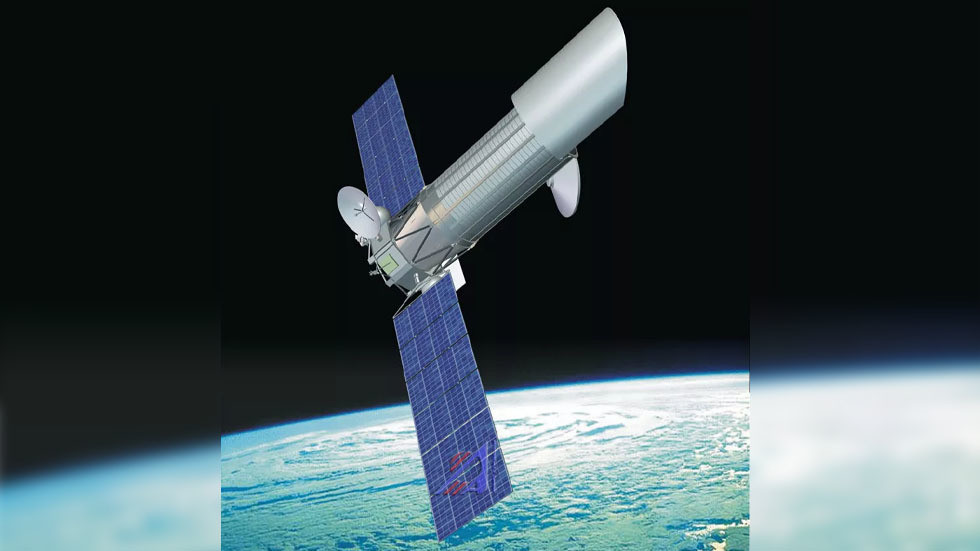Snip:

 www.space.com
By Ben Turner about 6 hours ago
www.space.com
By Ben Turner about 6 hours ago
The asteroid could be rammed by 23 of China's Long March 5 rockets
Reference: Dated Feb 17

 www.nasa.gov
Double Asteroid Redirection Test (DART) Mission
www.nasa.gov
Double Asteroid Redirection Test (DART) Mission
BOLID #SPMN120721E ON THE COAST OF MOROCCO recorded last night July 12 at 22h58m49s TUC from Estepa (Seville) by Antonio J. Robles (@AJ_Robles ). It is extinguished after a big explosion @AstroAficion @GruposEstelares @astroamics @Vista_al_cosmos @AstroyFisica @FireballsSky
Meanwhile is it a Rock or a UFO..?
Luke Miller has on two occasions recorded by chance, flying objects that cannot be identified by the lens of his camera, when he wascapturing the Moon, from London,#Inglaterra . Astro Photography.#Photography#Moon#UfoBy: (Instagram).
Did you know that NASA is going to send a spacecraft on a suicide mission in an attempt to change the trajectory of a massive space rock? The good news is that the space rock that NASA will be crashing this spacecraft into is not on a collision course with Earth. It is only a test. But why has NASA suddenly become so concerned with figuring out how to defend the Earth from giant asteroids? Could it be possible that there is something heading toward Earth in the future that they haven’t told us about yet?
According to NASA, there are more than 26,000 asteroids that pass near Earth, and more than 2,000 of them are classified as “potentially dangerous” asteroids.
Most of those “potentially dangerous” asteroids aren’t that large, but 158 of them do have a diameter of more than one kilometer.
If one of those monsters were to hit us, it would be a disaster of cataclysmic proportions.
Of course there are countless other space rocks that our scientists have not discovered yet, and those probably represent the greatest threat. Because if you don’t see a threat coming, you can’t get prepared for it in advance.
These days, NASA officials have become quite preoccupied by the threat that giant space rocks potentially pose, and we are being told that “scientists are at work on a plan to avoid the destruction of Earth by an errant asteroid”. The following comes from an article that was just published by the Boston Globe…
NASA and a cadre of the world’s leading engineers and space scientists are at work on a plan to avoid the destruction of Earth by an errant asteroid like the one 65 million years ago that wiped out the dinosaurs, created a cloud of dust so impenetrable that it blocked out the sun, and plunged the planet into a prolonged winter that sent half of all plant life into extinction.
Personally, I think that this is something that NASA should definitely be focusing on, because the threat is very real.
Most people don’t realize this, but our planet is actually being pelted by space debris on a constant basis at this point. In fact, NASA says that we are being hit by very small objects “every day”…
Every day, Earth is bombarded by tons of dust and sand-sized particles from the solar system. Meteoroids burn up as they enter the Earth’s atmosphere causing little or no damage. They are easy to spot, streaking across the night sky in brilliant, short-lived bursts of light. Of more concern are the asteroids that pass by Earth unnoticed; they are difficult to detect and track as observers depend on reflected sunlight to spot them.
Thankfully, the vast majority of the objects that we encounter are too small to do any damage.
But it is just a matter of time before a really big space rock comes along.
NASA officials like to give the impression that they have a really good idea of what is going on up there, but the truth is that our ability to detect large space rocks is still quite limited. In May, a “potentially hazardous” asteroid that came close to Earth was only discovered about a week before it arrived…
The reason why 2021 KT1 is news is that NASA estimates that it’s between 492 feet/150 meters and 1,082 feet/330 meters in diameter. It wasn’t observed until late in May 2021 just a week before its closest pass.
* * *

China wants to launch asteroid-deflecting rockets to save Earth from Armageddon
The asteroid could be rammed by 23 of China's Long March 5 rockets
The asteroid could be rammed by 23 of China's Long March 5 rockets
Chinese scientists are planning to fire more than 20 rockets into space to divert an asteroid impact that has a small chance of one day ending life on Earth.
Their target is an asteroid named Bennu, a 85.5-million-ton (77.5 million metric ton) space rock that is on track to swoop within 4.6 million miles (7.5 million kilometers) of Earth's orbit between 2175 and 2199. Although Bennu's chances of striking Earth are slim — at just 1 in 2,700 — the asteroid is as wide as the Empire State Building is tall, meaning that any collision with the Earth would be cataclysmic.
The estimated kinetic energy of Bennu's impact with Earth is 1,200 megatons, which is roughly 80,000 times greater than the energy of the bomb dropped on Hiroshima. For comparison, the space rock that wiped out the dinosaurs delivered about 100 million megatons of energy, Live Science previously reported.
Related: The 7 strangest asteroids: Weird space rocks in our solar system
Scientists at China's National Space Science Center calculated that 23 Long March 5 rockets, each weighing 992 tons (900 metric tons), pushing against the rock simultaneously would be necessary to divert the asteroid away from a fatal course by nearly 6,000 miles (9,000 km) — 1.4 times the Earth's radius. Their calculations are detailed in a new study published in the forthcoming Nov. 1 issue of the journal Icarus.
"Asteroid impacts pose a major threat to all life on Earth," Mingtao Li, space science engineer of the National Space Science Center in Beijing and lead author of the new study, wrote in the paper. "Deflecting an asteroid on an impact trajectory is critical to mitigating this threat."
The Chinese scientists' plan would sidestep the need to stop the asteroid by more direct, yet riskier, means — like the atomic bomb method popularized by Bruce Willis in the film "Armageddon." In reality, nuking the incoming space rock would break it into multiple smaller chunks that could still collide with Earth, leading to devastating consequences.
The Chinese plan follows a similar, yet slightly more costly, past proposal made by the United States. The NASA plan, called Hypervelocity Asteroid Mitigation Mission for Emergency Response (HAMMER), would send a fleet of 30-foot-tall (9 meters) spacecraft with battering rams to bump the asteroid off course. NASA simulations suggest that 34-53 blows from HAMMER spacecraft, launched 10 years before Bennu collides with Earth, would be needed to shift the asteroid.
NASA and the ESA (European Space Agency) will be the first to test a novel asteroid nudging method in two joint missions launching November 24 of this year. The DART mission (Double Asteroid Redirection) will send a spacecraft to arrive a year later at the 7 million mile (11 million kilometer) distant Didymos asteroid system. Once there, the NASA spacecraft will slam into Didymos's moonlet — a rock in orbit around the asteroid. The ESA's mission, Hera, will then monitor how DART has budged the moonlet off-course.
Bennu is a B-type asteroid, which means that it contains high amounts of carbon and, potentially, many of the primordial molecules present when life emerged on Earth. NASA already sent a spacecraft, called Osiris-Rex, in pursuit of samples from the asteroid. Osiris-Rex arrived above Bennu in October 2020, floating above it for long enough to collect loose pieces from its surface with its 10-foot (3 m) arm. Osiris-Rex is expected to return to Earth with its spoils in 2023.
Long March 5 rockets are the workhorses of China's space program, completing most of the deliveries to China's space station and launching Chinese probes to Mars and the moon. The rockets have caused concern in the past due to their uncontrolled reentry to Earth. In May, the 22-ton (20 metric ton) section of a Long March 5 rocket fell to Earth, either burning up or landing in the sea near the Arabian peninsula. In May 2020, fragments from a previous March 5 rocket were believed to have crashed into two villages in the Ivory Coast. Originally published on Live Science
Reference: Dated Feb 17

Planetary Defense - DART - NASA Science
NASA’s Double Asteroid Redirection Test (DART), built and managed by the Johns Hopkins Applied Physics Laboratory (APL) for NASA’s Planetary Defense
The binary near-Earth asteroid (65803) Didymos is the target for the DART demonstration. While the Didymos primary body is approximately 780 meters across, its secondary body (or “moonlet”) is about 160-meters in size, which is more typical of the size of asteroids that could pose the most likely significant threat to Earth. The Didymos binary is being intensely observed using telescopes on Earth to precisely measure its properties before DART arrives.
BOLID #SPMN120721E ON THE COAST OF MOROCCO recorded last night July 12 at 22h58m49s TUC from Estepa (Seville) by Antonio J. Robles (@AJ_Robles ). It is extinguished after a big explosion @AstroAficion @GruposEstelares @astroamics @Vista_al_cosmos @AstroyFisica @FireballsSky
Meanwhile is it a Rock or a UFO..?
Luke Miller has on two occasions recorded by chance, flying objects that cannot be identified by the lens of his camera, when he wascapturing the Moon, from London,#Inglaterra . Astro Photography.#Photography#Moon#UfoBy: (Instagram).





 Yes, we at been consuming some wine so our awareness was rather dull.
Yes, we at been consuming some wine so our awareness was rather dull.
